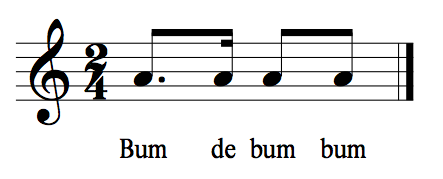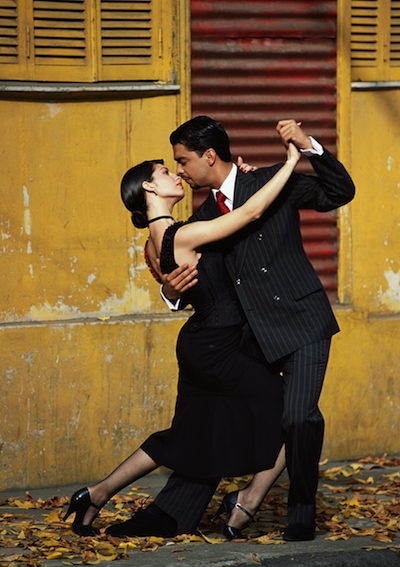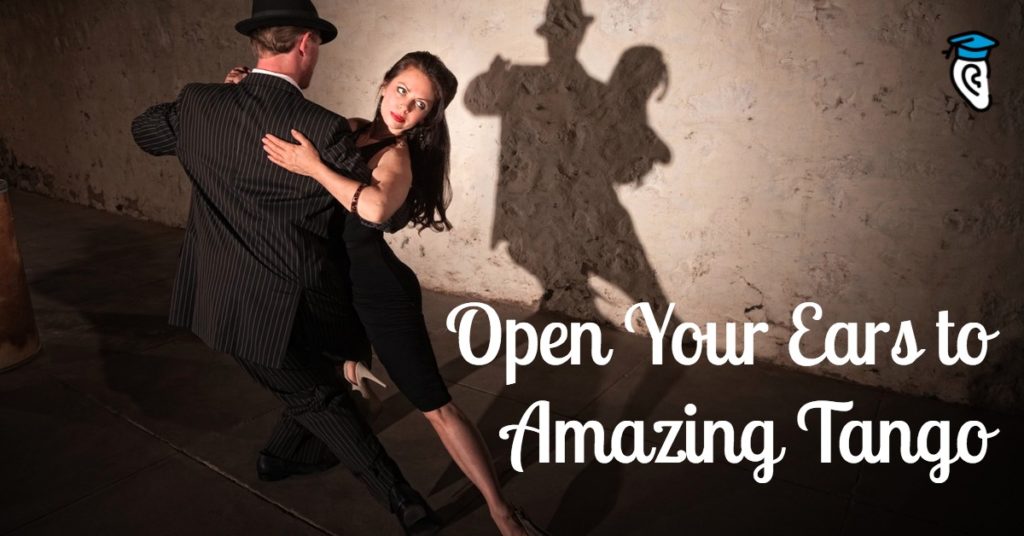The history of tango as a musical form is somewhat muddled. Scholars have traced the African origins of the word and the genre, and today there are many variants of tango tradition in different regions of Argentina, Uruguay, Brazil, and other nations. However, to keep it simple, we’ll focus on Argentinian tango, which is frequently (but not always) accompanied by the urban dance internationalized since the early 1900s.
We’ll be listening to Episode 44 of the 5 Song Set podcast:

The shifting patterns in that ubiquitous tango rhythm can mess with your mind. Is it in “2” or “4”? It’s more vital to get the essence of the rhythm and then maintain a certain flexibility as you move among pieces that boast the label “tango.”
In this short set of tango and some of its related forms, like milonga and vals, expect some fascinating diversion from the standard in terms of meter, melody, harmony, and form. Also, enjoy the variety of instrumental combinations, augmenting the traditional bandoneón, violin, winds, bass, piano and vocals.
Cosa de Negros – Andrés Drimer
This is a perfect introductory piece to warm up the ears, with a sharp and distinctly duple meter so typical of traditional tango. The rhythmic is built from a jaunty “bum-de-bum-bum” pattern—very tango!

In play is a standard ensemble, with signature sounds of the guitar and bandoneón. The bandoneón looks like a concertina on steroids and sounds a bit like an accordion. But the particular construction of the instrument allows for more expressive control over the sound through accents, vibrato, and other techniques.
All instruments fade to the background when the baritone voice enters at [0:09] to initiate a modified strophic song form. At [0:35] you hear an instrumental interlude that mimics the song’s opening and serves to introduce verse two at [0:42]. An instrumental bridge is launched at [1:15], based on a bandoneón solo with guitar accompaniment, then at [1:37] note the recurrence of that instrumental introduction.
Verse 3 begins at [1:46]. Listen for the word “milonga” in the singer’s lyrics. Prevalent in rural Argentina, milonga is another contributor to the tango’s rich stylistic hybridity. Milonga calls for unadorned poetic commentary recited over a strong, steady rhythm and traditional chord progression. This vocalist’s playful, speech-like declamation recalls the improvisatory nature of traditional milonga.
La llorona – Trio Nocturna
The musicians of Trio Nocturna (now known as Nuevo Nocturna) hail from the Netherlands, indicating the tango’s international reach.
La llorana reveals the structural and rhythmic flexibility of tango-related genres, with its obvious connection to the waltz. If you tend to count it in either a slower “2” or faster “3”, then you’re leaning into this song’s compound meter. While dance-like, this does differ from the simple meter of typical tango.
Listen at [1:10] for the guitar’s scalar improvisation rushing over that “oom-pah-pah” foundation. Note how much more virtuosic the solo becomes toward the [1:30] mark, as the player deftly moves through highly ornamented melodic content.
Then, at [2:02] things calm and come full-circle, rounding back to the opening melody to initiate verse 2 at [2:17]. I love how the vocals become more impassioned toward the end: listen carefully around [3:00], where voice and instruments fall into a lock-step rhythm that ramps up the tension.
Tempo too brisk for dancing? Let’s label it as “stylized” dance—probably more for listening than for cutting the rug.
Vals Considerao – Walton/Van Duinen
This piece opens with a tangible dissonance, a clash caused by the simultaneous sounding of pitches that lie close in interval distance. This makes for a “crunchy” sound when compared to pitches set apart at wider intervals. The short flourish (before the voice enters at [0:05]) sets the stage for other fascinating forays outside of the diatonic scale.
Per the title, you should be expecting a steady triple meter feel, since “valsv” translates to “waltz.” Don’t think smooth, legato, Viennese waltz, though; instead, the “tango vals” offered significant overlap to tango dance traits with its richer syncopation and a choppier movement. We can give the urban waltz hold and step credit for opening the door to the intimate couple’s “hug” that a tango requires. Scandalous back in the day!
Overall, I somehow sense an improvisatory vibe to this piece. Listen at [1:08-1:34], where the economical duo of bandoneón and guitar balance beautifully across high and low melodic ranges. I like to think that the artists are celebrating the historical practices of these popular forms, where casual performances yielded something different every time.
At [2:30] note how the lovely (if short-lived) instrumental interlude handily introduces the next verse, demonstrating that you can still count on a set strophic song form. That is, after all, the structural standard typical of popular song, even to this day: it just makes sense in how well it manages a listener’s expectations, with the same music repeating to a fresh poetic stanza each time.
Cabaret – Ber Stinco
Cabaret opens with a substantial instrumental introduction (mirrored in an equally lengthy postlude at [2:30] to sort of “book-end” things) to secure the distinct habanera/tango metrical pattern (the Cuban habanera was a critical rhythmic source for both tango and milonga). The pattern comes across as looser or less forceful here compared to the first number of the set, but the more leisurely rhythmic formula still maintains the required accent pattern and expected momentum.
What’s unique here is the wailing clarinet which lends a lyrical and melancholy feel with its distinct timbre. Listen to how it interfaces seamlessly with the voice (note in particular a “dialogue” between clarinet and voice starting at [1:34]), weaving a polyphonic texture in the call and response interaction. The guitar adds to this active, dense texture with the signature tango rhythm.
That persistent clarinet seems to alternate between soloist and accompanist, emerging clearly then diving back down into the texture, staggering through a flourishing melodic pattern that is set in its higher range. I’m especially drawn to its unexpected “shouts” as the song forges ahead.
The logical structure still plays out in this compact strophic form, where verses are delivered via a rather rough, raspy vocal style, pushing certain key words.

Canaro en París – Tarjeta Roja
This purely instrumental tango is the most playful of the five presented here, and at the same time comes across as quite dramatic in light of its vivid tango imagery. Picture the couple’s dance we all know from the movies, thanks to traits like a moderate tempo and embedded syncopation, where the expected beat accents shift around in the metrical pattern.
The bandoneón timbre is prominent throughout, but competes with the rich colors, wide range, and texture-thickening abilities of the piano’s intrusion, whose entrances surprise the listener—like that virtuosic flourish at about [0:22].
The regular melodic pattern is skewed at [1:27] when all of a sudden a unison chromatic scale sounds front and center, with ascending motion in the piano overlapping on the way down. At [1:35] more motive-driven melodic phrases return but with striking bandoneón punctuations.
At [1:50] enjoy the piano’s more soloistic passage, as the bandoneón is relegated to the background, then note how they switch places at [2:05]. The trading off inside a homophonic texture is pretty exhilarating!
Overall, the piece sticks to a motoric tango rhythmic pattern, but it’s obscured at [2:20]. This bridge is probably the most exciting segment of the piece, thanks to the melodic layers that accumulate, including the unmistakable sound of electric guitar! Seems odd? Well, famed tango revolutionary Astor Piazzolla introduced the option of electric guitar way back in the 1960s, so enjoy.
One more decided shift in character comes at [2:51], where movement declines to a dramatic slowing of the tempo toward the dance’s final cadence.
It Takes Two to Tango
Tango music continues to evolve in fresh, surprising ways. Our brief look has revealed expressions varying from the rough folkish spontaneity of Ber Stinco to the almost classical refinement (coupled with tango energy) of Tarjeto Roja.
It almost seems that tango thrives on merging two or more genres together. As you open your ears to tango, find someone else to share your experience with—you’ll be glad you did!








